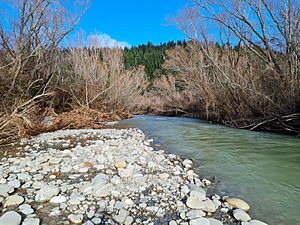Selwyn River facts for kids
Quick facts for kids Selwyn River |
|
|---|---|
| Lua error in Module:Location_map at line 420: attempt to index field 'wikibase' (a nil value).
Location of the mouth within New Zealand
|
|
| Other name(s) | Selwyn River / Waikirikiri |
| Country | New Zealand |
| Physical characteristics | |
| Main source | Southern Alps |
| River mouth | Lake Ellesmere / Te Waihora |
| Length | 80 km (50 mi) |
The Selwyn River is a river in the South Island of New Zealand. Its official name is Selwyn River / Waikirikiri. The Māori name, Waikirikiri, means "gravelly water." This river flows through the Selwyn District in Canterbury.
Contents
About the Selwyn River

The Selwyn River starts in the Southern Alps. It flows east for about 80 kilometers (50 miles). Then, it empties into Lake Ellesmere / Te Waihora, which is south of Banks Peninsula. The town of Whitecliffs got its name from the cliffs above the river's upper parts.
For most of its journey, the river flows over wide beds of small stones. During dry times, the river can seem to disappear. The water goes beneath the stony riverbed. This often happens where State Highway 1 crosses the river. This spot is near the settlement of Selwyn.
In the hills, the Selwyn River always has water. But on the flat plains, the riverbed lets water soak through easily. The water leaks down into a deep, porous aquifer (an underground layer of rock or sand that holds water). Because of this, most of the river's water disappears within 5 kilometers (3 miles) of leaving the hills. For about 35 kilometers (22 miles), the riverbed stays dry for most of the year. However, it becomes wet again about 15 kilometers (9 miles) before it reaches Lake Ellesmere / Te Waihora. This is where shallow groundwater rises back to the surface.
Bridges Crossing the River
There are six bridges that cross the Selwyn River. You can find them at:
- Whitecliffs (Whitecliffs Road)
- Glentunnel (SH 77)
- Coalgate (Hororata Road)
- Hororata (Bealey Road)
- Selwyn (SH 1)
- Irwell (Leeston Road)
You can also cross the river at Coes Ford when the water levels are low.
River Life and Ecosystem
When the river's surface water disappears, it affects the plants and animals living there. Many aquatic (water-based) plants and animals lose their homes. Fish and small water creatures must move to other wet areas, find a safe spot, or they might die. Water plants, algae, and bacteria have to go into a resting state or die.
The dry middle parts of the Selwyn River also make it hard for fish to travel. They cannot easily move between Lake Ellesmere / Te Waihora and the river's source.
Fishing in the Selwyn
The Selwyn River used to be famous for its trout fishing. In the 1960s, a special trap at Coes Ford counted up to 14,000 trout returning to lay their eggs. However, by 2017, only dozens of trout were counted. Today, there are fewer fish in the river, and most of them are quite small.
Water Quality and Pollution
The water quality in the Selwyn River has become a concern. Some people believe that intensive dairy farming in the area has made the water worse. In May 2021, reports showed that nitrate levels in the river had increased by 50%. Nitrates are chemicals that can come from farm runoff.
It is now not recommended for people to swim in the Selwyn River. Coes Ford was once a popular swimming spot. In 2020, the water at Coes Ford had some of the highest nitrate levels in New Zealand. This pollution is thought to come from Silverstream Creek, which used to be surrounded by many dairy farms.
In December 2020, a health warning was issued for Chamberlain's Ford due to an algal bloom. These are large growths of algae. Benthic cyanobacteria, a type of algae, were found in the river. Algal blooms have also been reported in the Selwyn River at Whitecliffs Domain and Whitecliffs Road in March 2021.
In February 2020, Greenpeace placed billboards in the Selwyn River. This was to protest the level of pollution in the river.
How the River Got its Name
The Selwyn River and its gorge were named in 1849. This was done by Joseph Thomas, a chief surveyor. He named them after Bishop Selwyn. Later, the name Selwyn was also used for the township, the district, and an electorate (a voting area).
The New Zealand Ministry for Culture and Heritage says that the Māori name, Waikirikiri, means "gravelly stream."
See also
 In Spanish: Río Selwyn / Waikirikiri para niños
In Spanish: Río Selwyn / Waikirikiri para niños

